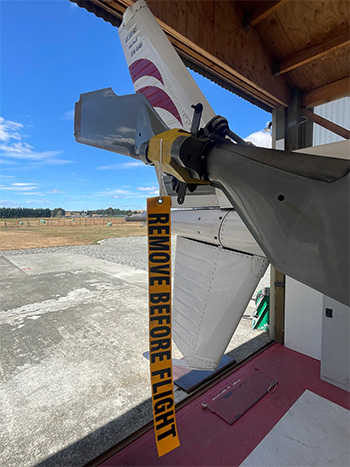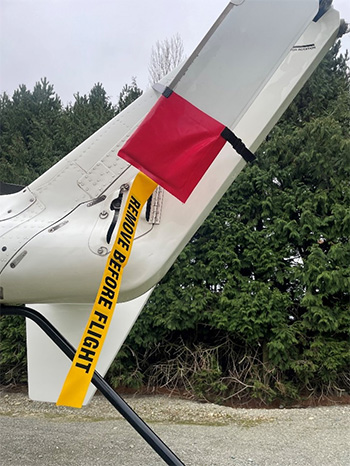By Southern Lakes Helicopters
 In the middle of a firefighting op, we had an occurrence that taught us a lot about what to do better.
In the middle of a firefighting op, we had an occurrence that taught us a lot about what to do better.
In April 2022, in the final days of a firefighting operation east of Invercargill, we experienced an occurrence which we were fortunate did not end in a severe outcome.
We want to share what we learned to reduce the chance of other pilots experiencing a similar situation.
What happened?

The hi-vis ribbons on the tail rotor chock didn’t stand out as well as they should have. Photo courtesy of Southern Lakes Helicopters.
On the morning of the occurrence, the pilot conducted an aerial survey and positioned a crew onto the fire ground. He then returned to base to shut down – there were no more commitments until later in the day.
After the pilot shut down, he noticed the tail rotor was flapping due to the winds gusting 20–25 knots. They were forecast to increase so he installed the tail rotor chock.
Immediately after, an official came over to send him back to the fire ground to carry out some bucketing.
The pilot accepted the job and began preparing the aircraft. He removed the door and the pod, and stored them away from the aircraft where they’d be protected from rotor wash and the wind.
He then connected the fire bucket and performed his pre-start walkaround, to make sure the aircraft was configured correctly and that it was safe to start.
There were seemingly no problems, so he lifted into a hover and turned into wind. All the controls seemed to be functioning normally.
While enroute to the dipping pond, however, the pilot began experiencing reduced pedal capability.
After working through some problem-solving and effect of controls, he was unable to rectify the situation, so he aborted the mission and transmitted a MAYDAY call to the Invercargill tower.
The pilot identified a safe landing area, clear of hazards, then jettisoned the bucket and made a safe landing.
Once on the ground, he confirmed with the tower that he was okay, and he needed no further help.
The pilot shut down the aircraft, disembarked, and walked around to see…the tail rotor chock was still installed.
Why did it happen?

Southern Lakes Helicopters have “made and installed new hi-vis yellow tail rotor chock ribbons. They’re much shorter than the standard ones and are unlikely to slap against the aircraft. They cannot be tied up around the tail rotor hub, and out of sight.” Photo courtesy of Southern Lakes Helicopters.
During our investigation, we identified a number of things which led to this.
On this occasion, the pilot didn’t leave a witness indicator
The pilot’s normal routine was to place his helmet over the cyclic – as is the practice of many other pilots –to indicate the aircraft has tie-downs installed.Unfortunately this time, for whatever reason, he didn’t place his helmet as he normally would have.
Distraction
An unexpected change in a job or plan is enough to throw anyone off track. We want to emphasise how important it is that when people are distracted in the workplace, they first stop and assess the urgency of the distraction, and respond accordingly.
This means if they’re in the middle of something critical, such as a preflight, or reconfiguration, they either ask for a couple of minutes to finish what they’re doing and then have the conversation, or, if they decide it’s urgent, they leave a marker where they’ve got to. But it’s preferable they restart their checks or duties, right from the beginning.
The hi-vis ribbons on the TRC had become dull and faded
Many pilots will be familiar with the dull orange ribbon attached to the tail rotor chock. Our ones didn’t stand out as well as they should have.
The hi-vis ribbons were longer than they needed to be, and the pilot tied it up around the tail rotor
When we spoke to other operators, it seemed common practice for pilots to tie the ribbons around the tail rotor hub, so they don’t flap against the aircraft. But, once they’re tied up, they’re extremely difficult to see.
There was minimal knowledge of, or familiarity with, the use of picketing items, particularly the tail rotor chock
Once again, talking to other operators, we found there was a wide range of opinions about how or when these items should be installed or not installed. We also felt the instructions for the use of picketing items in the aircraft flight manual were also light and non-informative.
There was a lack of company documentation relating to the tying-down of aircraft
We didn’t have any procedures or guidance material relating to the use of these items.
What didn't happen?
As far as we could identify, we were able to rule out some other typical human factors.
Fatigue
This was day three for the pilot, after three days off.
Mission or time pressure
This was day 14 of the fire response and the emergency was very much over. The pilot has proven experience in SAR, medivac and firefighting operations. It’s unlikely the pilot was feeling any pressure to perform these tasks.
So what happens now?

Southern Lakes Helicopters have designed and made a ‘witness indicator’ which is placed on top of the cyclic. Photo courtesy of Southern Lakes Helicopters.
We’ve designed and made a ‘witness indicator’ or cyclic sock for our entire fleet, which is placed on top of the cyclic. It’s bright red with a yellow tail stating in bold, ‘Tie down & tail rotor’.
When tying down the aircraft, the witness indicator must go on first, before any picketing items are installed.
In reverse, it’s the very last item to be removed after all the picketing items are off. We use the mantra, First on, last off. For this to work, the cyclic sock remains in the top of the stow bag when not in use.
The value of this process was highlighted a month later during a search and rescue operation. After aborting a night rescue attempt due to weather, the pilot tied down the aircraft for the night. A new pilot began the operation the following morning and was able to walk around the aircraft knowing picketing items were installed, including the tail rotor tie-down. After the pilot removed and accounted for all picketing items, the cyclic sock was removed and placed into the top of the bag.
This process is especially important for pilots undertaking operations in darkness or performing their preflight checks before sunrise.
The company now requires that, if the tail rotor chock is installed, our pilots must also install the blade tie-downs.
We’ve made and installed new hi-vis yellow tail rotor chock ribbons. They’re much shorter than the standard ones and are unlikely to slap against the aircraft. They cannot be tied up around the tail rotor hub, and out of sight.
These items are supported by a company SOP and were made locally in Fiordland by an upholsterer.
We’ve better defined ‘distraction’ in our company hazard register, and developed further control measures and tools for pilots and ground crew.
We added the use of picketing items into the company hazard register.
What else happens now?
We continue to promote the importance of the pre-departure walkaround for all operations. We know from previous occurrences that pilots who don’t participate in this inspection are more likely to experience a problem.
Two months before the occurrence, we began a random risk-based audit over the course of six months. Company auditors were observed and photographed all pilots participating in this. We were pleased to see a high level of continuity and process being undertaken by our staff, and we expect this routine will continue.
We engaged with the CAA and the aircraft manufacturer to suggest further guidance material for pilots in relation to the use of picketing items.
What do we recommend happens at your operation?
Ensure your team gets together to discuss your thoughts, experiences, and expectations around the use of picketing items. This includes, why, what, when, and how.
Make some witness indicators suiting your aircraft type and functions. In our case, we designed the ‘cyclic sock’.
Avoid tying up or removing hi-vis ribbons from the tail rotor chock or any other picketing items that have them installed. They are there for a reason and that’s to get attention.
Check the condition of the hi-vis ribbons. Are they clean and bright? If not, get new ones. Make sure they stand out.
Consider replacing your blade tie-down ropes with new hi-vis lines.
Ensure all pilots continue to perform the pre-departure walkaround procedures.
Discuss the issue of distraction with your whole team. What does this mean? How do you deal with it? This also means making sure your staff aren’t the ones being the distraction.
Summary
We all know how lucky we are that this occurrence didn’t result in disaster. The pilot performed his emergency procedures exceptionally, thanks to his experience and ongoing training.
We hope our lessons and actions will help others avoid a similar situation in the future.
Now is a good time to talk with your team and your peers.
